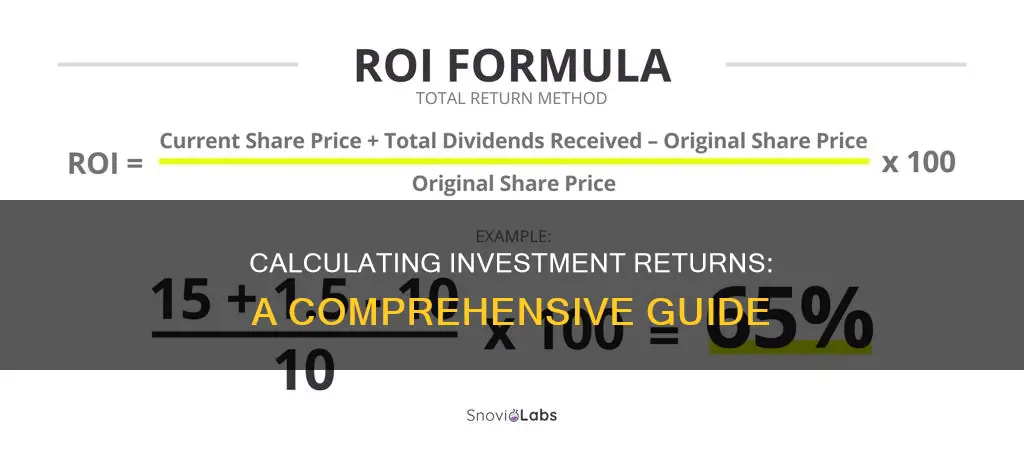
The payback period is a crucial metric in investment, indicating the amount of time required to recoup the initial cost of an investment or reach its break-even point. It is calculated by dividing the cost of the investment by the annual cash flow, with shorter payback periods generally considered more attractive. This concept is especially relevant for investors, financial professionals, and corporations when evaluating potential investments and understanding the risk-reward ratio. The payback period is a simple yet effective tool for risk assessment and investment comparison, helping investors make informed decisions about their financial future.
| Characteristics | Values |
|---|---|
| Purpose | To recoup the cost of an initial investment |
| Calculation | Divide the cost of the investment by the annual cash flow |
| Formula | Payback Period = Initial Investment / Yearly Cash Flow |
| Types | Averaging method, Subtraction method, Discounted payback period |
| Factors | Cash flow, Time value of money, Risk, Returns |
| Use Cases | Personal investments, Business investments, Financial planning |
| Benefits | Simple to understand, Useful for risk assessment, Helps compare investment options |
| Downsides | Doesn't account for time value of money, Ignores long-term benefits, Limited applicability |
What You'll Learn

How to calculate the payback period
The payback period is the amount of time it takes to recover the cost of an investment, or how long it takes to reach the breakeven point. It is a metric used by investors, financial professionals, and corporations to assess the feasibility of an investment or project.
The payback period can be calculated using the following formula:
Payback Period = Initial Investment / Annual Cash Flow
Here, the initial investment refers to the upfront cost of the investment or project, and the annual cash flow represents the net cash inflow generated by the investment on a yearly basis. The resulting number is expressed in years or fractions of a year.
For example, let's consider a company that invests £200,000 in new manufacturing equipment, resulting in a positive cash flow of £50,000 per year. Using the formula, the payback period would be:
Payback Period = £200,000 / £50,000 = 4 years
This means it will take four years for the company to recover its initial investment of £200,000.
Advantages and Disadvantages of the Payback Period
The payback period is a quick and simple method for evaluating investments and projects. It provides a straightforward way to compare different opportunities and assess risk. The shorter the payback period, the more attractive the investment, as it indicates a faster recovery of the initial investment.
However, one of the drawbacks of the payback period calculation is that it does not consider the specific profitability of an investment beyond the breakeven point. Additionally, it does not take into account the time value of money, which assumes that money today is worth more than the same amount in the future due to factors like depreciation and earning potential.
To address these limitations, investors often use alternative methods such as the discounted payback period, net present value (NPV), or internal rate of return (IRR), which incorporate the time value of money and provide a more comprehensive assessment of investment risk and profitability.
Overseas Investment: Why the Move?
You may want to see also

What is a good payback period?
The payback period is the amount of time it takes to recover the cost of an investment and reach a breakeven point. It is a commonly used method to calculate investment returns and helps determine how long it takes to recover the initial costs associated with an investment.
The shorter the payback period, the more attractive the investment. This is because money can be invested to earn a return over time, so the value of money increases as it earns interest or other investment returns. A shorter payback period also means reduced risk.
However, there is no definitive "good" payback period, as it depends on the asset class (real estate, venture capital, debt investment, etc.). For example, the payback period for a home improvement project can be decades, while the payback period for a construction project may be five years or less.
- For B2C businesses, a payback period of less than 1 month is GREAT, 6 months is GOOD, and 12 months is OK.
- For B2B businesses selling to SMBs, less than 6 months is GREAT, 12 months is GOOD, and 18 months is OK.
- For B2B businesses selling to enterprises, less than 12 months is GREAT, 18 months is GOOD, and 24 months is OK.
Where to Invest: Personal Preferences
You may want to see also

Drawbacks of the payback period method
The payback period method is a popular choice for managers due to its simplicity and ease of understanding. However, it has several drawbacks that should be considered when evaluating investment decisions:
- Ignores Time Value of Money: The payback period method fails to account for the time value of money (TVM), which is a crucial concept in finance. TVM recognises that money received today is worth more than the same amount in the future due to its potential to generate returns or interest over time. By ignoring TVM, the method distorts the true value of cash flows and can lead to inaccurate investment decisions.
- Limited Consideration of Cash Flows: The payback method only considers cash flows until the initial investment is recovered. It disregards cash flows that occur in subsequent years, which may result in overlooking projects with higher long-term profitability. This limitation can be addressed by using the discounted payback period, which takes into account the present value of future cash flows.
- Overemphasis on Short-Term Gains: The payback period method favours projects with shorter payback periods, potentially neglecting projects with higher overall profitability in the long term. A project with a shorter payback period is not necessarily more profitable, as cash flows may decline or stop after the payback period ends.
- Simplistic Nature: While simplicity is an advantage in certain contexts, the payback method's simplicity can also be a drawback. It fails to capture the complexity of cash flows associated with capital investments, which often involve irregular cash inflows and additional cash outflows over time.
- Ignores Profitability: The payback method focuses solely on the recovery of the initial investment and does not consider the overall profitability of a project. This can be problematic, as a project with a shorter payback period may not necessarily be more profitable than one with a longer payback period.
- Neglects Other Factors: The method does not take into account important factors such as risk, financing, and the return on investment. These factors play a significant role in investment decisions and should be considered in conjunction with the payback period to make more informed choices.
Why People Invest: Unlocking Motivations
You may want to see also

Discounted payback period
The discounted payback period is a capital budgeting procedure used to determine the profitability of a project. It is a modified version of the payback period that accounts for the time value of money. It gives the number of years it takes to break even from undertaking the initial expenditure, by discounting future cash flows and recognizing the time value of money.
The discounted payback period is calculated in two steps. First, the net cash flows that will occur during each year of the project must be discounted (i.e., brought to the present value). Second, these discounted cash flows are subtracted from the initial cost figure to obtain the discounted payback period. This process is repeated until the initial cost is reduced to zero.
The formula for the discounted payback period is:
> Discounted Payback Period = Years Until Break-Even + (Unrecovered Amount / Cash Flow in Recovery Year)
The discounted payback period is considered a more accurate method than the simple payback period, as it takes into account the time value of money. However, one disadvantage is that it ignores cash flows after the payback period, which may lead to decisions that contradict NPV analysis.
Smart Places to Invest $400K Today
You may want to see also

Alternatives to the payback period
The payback period is a simple way to evaluate the feasibility of an investment or project, but it has some key weaknesses. It does not take into account the time value of money, the risk of the project, or the cost of capital. It also ignores cash flows beyond the time horizon, which may be substantial. As such, it is sometimes used as a preliminary evaluation, supplemented with other methods. Here are some alternatives to the payback period:
- Net Present Value (NPV) Method: This method addresses the payback period's limitations by examining all cash flows, both positive (revenue) and negative (costs), associated with a project. The value of future cash flows is adjusted or "discounted" to reflect their worth in the present day, taking into account inflation, risk, and the cost of capital. The project is worth pursuing if the NPV is positive and rejected if it is negative.
- Internal Rate of Return (IRR) Analysis: IRR analysis is another alternative to the payback period. It involves forecasting free cash flows into the future and using the XIRR function in Excel to determine the discount rate that sets the Net Present Value of the project to zero. IRR does not consider risk, so it should be used alongside the payback period to make more informed decisions.
- Combining the NPV and Payback Period Methods: Businesses often use a combination of methods for capital budgeting decisions. One approach is to use the payback period to narrow down options and then apply the NPV method to identify the most promising projects. Alternatively, the NPV method can be used to separate profitable projects from unprofitable ones, and then payback periods can be considered to see which projects return their costs more quickly.
- Discounted Payback Period: This approach is similar to the traditional payback period but accounts for the time value of money. It discounts cash flows to reflect that a dollar received today is worth more than a dollar received in the future. This method provides a more accurate assessment of the time required to recoup the initial investment.
Investing: Control, Returns, and Excitement
You may want to see also
Frequently asked questions
The payback period is the amount of time it takes to recover the cost of an investment. It is the length of time an investment takes to reach a breakeven point.
The payback period is calculated by dividing the amount of the investment by the annual cash flow. The formula to calculate the payback period is:
Payback Period = Initial Investment ÷ Cash Flow Per Year
There are several ways to pay back investors, including dividends, share repurchases, debt refinancing, share dilution, asset sales, and debt financing.







